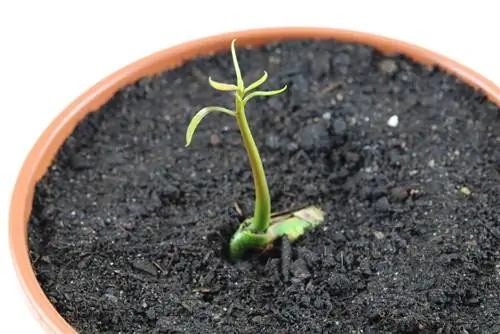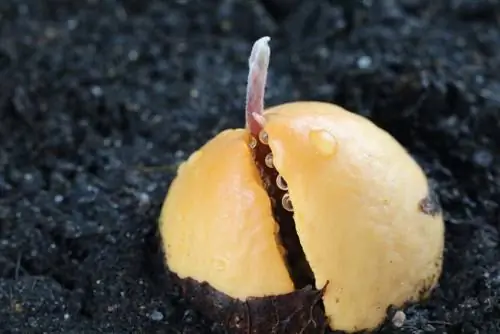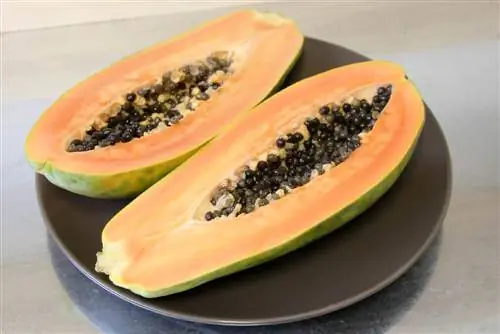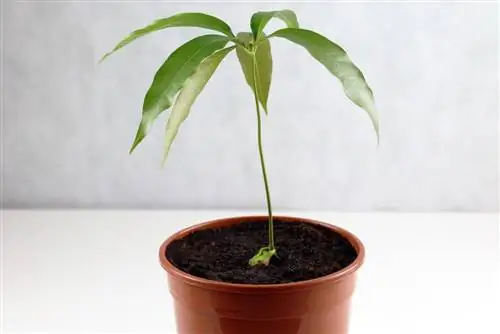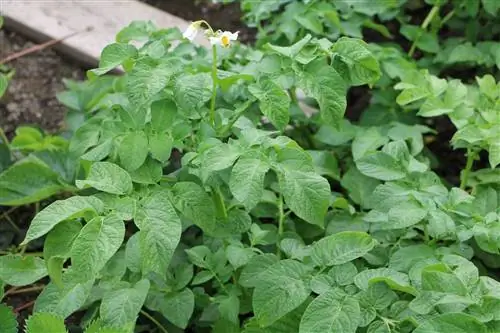- Author admin [email protected].
- Public 2023-12-17 03:39.
- Last modified 2025-01-24 12:45.
If you want to grow a mango tree yourself, you need a very ripe or overripe mango fruit that has not yet started to rot. The riper the mango, the easier it is to remove the seeds and the faster germination occurs. A ripe mango can be recognized by its leathery, wrinkled skin. Their pulp gives way even under slight pressure. The fruit exudes a strong, sweet scent. Black dots are visible on its shell.
Obtaining a suitable mango fruit or seed
If you take a mango directly from a fruit-bearing tree, it is an ideal seed donor. But this opportunity only arises in very few cases. The easiest way is to buy a mango from the supermarket. But these fruits could have been treated with germination inhibitors. In addition, the seed could have been damaged or dried out during the long journey the mango has taken. It is a little safer to buy a mango from a fruit merchant that is organically grown. Alternatively, you can buy a mango seed from a seed dealer. But in many cases, growing a mango plant from a fruit core works even if the fruit was purchased the easiest way and comes from the supermarket around the corner.
Allow the fruit to ripen
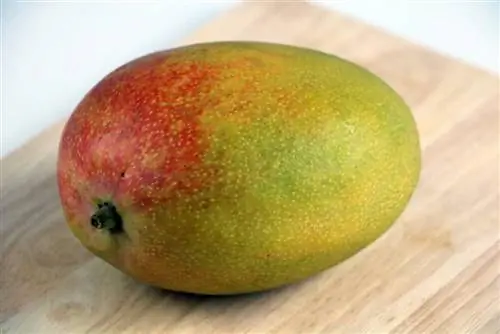
In a warm, sunny place, for example on the windowsill, the mango you purchased will continue to ripen a little. Only when it shows all the signs of a truly ripe fruit should you start extracting the seeds from it.
Removing the seed from the fruit
To remove the seed from the mango, special tools available from seed dealers can be used. Alternatively, sharp scissors, a sharp knife or a screwdriver can help with sperm collection. However, extreme caution is required to avoid injuring your own hands or damaging the seed core.
How to proceed:
- Peel mango
- Roughly remove the pulp from the core with a knife
- clean the outer core thoroughly of pulp residue
- Carefully split the core at the tip or pry it open using a sharp knife or a screwdriver.
Tip:
If it doesn't work on the top side, just turn the core around and see if it works easier on the bottom side. The two shells of the outer hard core do not need to be completely separated. It's enough to open the core a little. The soft, slightly kidney-shaped inner core is the actual seed.
- If the outer core is only opened, there is very little risk of the seed being damaged, but the germination time is four to six weeks
- Alternatively, the outer core can be completely removed from the seed
- To do this, split the hard core completely open or cut off the edges with sharp scissors and expose the seeds completely.
- It is essential to avoid damage to the inner core or the seed, otherwise its germination is unsafe.
- Finally, carefully remove all loose skins around the seed with your hand
Tip:
The kernel is easier to split if it is dried before opening. To do this, it should be dried with a paper towel and then placed in a sunny and well-ventilated place. In addition, the riper the mango, the easier it is to open the core.
Grouting seeds

There are various ways to germinate the seed obtained from the fruit. It can either be put directly into loose potting soil, or you can let it germinate in a freezer bag or in a sealable Plexiglas container. In the first variant, the germ appears after about four weeks. With the second variant, success can be visible after just a few days.
How to germinate in potting soil:
- Get a pot with drainage holes
- Create a loose substrate using peat, sand and coconut fibers or use ready-made potting soil
- Cover the bottom of the pot with pottery shards or stones to create drainage that ensures good water drainage
- Fill the pot with the prepared substrate
- Place the slightly opened core upright in the substrate or place the shellless seeds flat in the substrate and cover them lightly with soil.
- Wet the substrate well with low-lime water using a water spray bottle
- To maintain the humidity, the pot can then be covered with a transparent film or the spraying can be repeated daily.
- Place the pot with the germ in a bright place where temperatures are between 24 and 30 degrees.
Tip:
To avoid mold and disease, warm the potting soil to around 150 degrees before using in the oven.
This is how you proceed when germinating in a freezer bag or Plexiglas container:
- Get paper kitchen towels and moisten them with low-lime soap
- Put seeds on it
- Place a second layer of damp kitchen towels on the seed
- alternatively, wrap seeds in a damp cotton cloth
- Place a damp cloth or paper with seeds in a freezer bag or Plexiglas container
- Close the can or bag and place it in a place that is around 24 degrees warm and bright
- after a few days the desired germ can appear, which should then be placed in a pot to continue growing
The right care
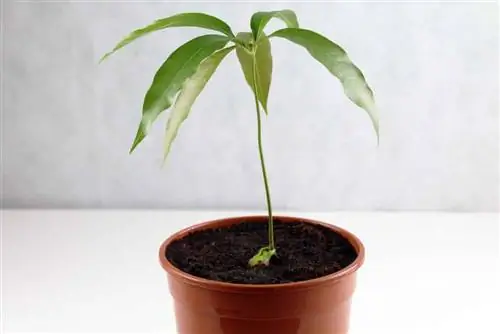
With the right tricks you can enjoy the plant for a long time and let it grow and thrive.
Location
In order to grow and thrive well, the mango plant, like the germ, needs a bright and warm location. However, full sun should be avoided as the young shoots could burn in the sun. As the plant ages, its sensitivity decreases. If you want to put your mango tree in the garden, you can do so from the age of two. Then it can be left outside in a bucket in the summer and in the sun. The plant can even tolerate slightly cooler temperatures. If you want to keep your room indoors all year round, we recommend a warm room with high humidity, such as the kitchen or bathroom. If the mango tree is in the ideal location, it is very easy to care for.
Fertilizing and watering
In the first few weeks after germination it does not need any additional nutrients. Although it requires a high level of humidity around itself, it rarely needs to be watered or fertilized. Watering once a week is sufficient. The plant prefers water with a low calcium content, such as rainwater or stagnant water. Waterlogging must be avoided. However, the leaves like to be misted daily. The plant should not be fertilized for the first time until the second month after sprouting at the earliest, otherwise it will grow too quickly and weakly. The fertilization frequency can be four to eight weeks.
However, an interval of three weeks is better. The substrate can be renewed occasionally to maintain the he alth of the plant. Since the plant does not take a winter break, the indoor culture must continue to be fertilized in winter. We recommend using commercially available houseplant fertilizer.
Repotting
Once the tree has reached a height of around 40 cm, the first pot change can take place. The plant does not need any trimmings. Indoors, the young mango tree can easily overwinter in a bright and warm place. A mango tree only thrives outdoors in a warmer region, such as southwest Germany or in wine-growing regions. That's why it's recommended to put the plant in a pot in the garden and bring it in in winter.
If you still want to plant the tree directly in the garden soil, you should keep in mind that it requires a lot of space because it can grow extremely high and its crown then develops very expansively. The roots also spread very much over the years, so there should be no other plants near the mango tree.
It is also recommended that you only plant the mango tree in the garden after about two years or when a larger, he althy root ball has already developed. At this point, the trunk of the tree should have a diameter of at least five centimeters in the lower area. A sunny spot is suitable as a location.
Fighting diseases

In its original growth areas, the mango tree can be attacked by fungi and pests. This danger exists especially when the tree bears fruit. In our regions this hardly exists. Spider mites, on the other hand, can make themselves noticeable through wilted or darkly colored shoots. The shoot tips can even turn black. The mites are particularly common in dry and warm air. To prevent them, it helps to moisten the leaves of the mango plant daily with a spray bottle.
A shower or spraying with a hose can also prove to be particularly effective against pests. To maintain the humid climate around the plant, it is recommended to cover it with transparent film. The higher the humidity, the faster the spider mites die. If there is a more severe mite infestation, the plant should remain covered with the film for about three days. It is then removed and the treatment is repeated after a week. In this way you can prevent the mango plant from rotting under the film and also remove the next generation of pests at the same time.

